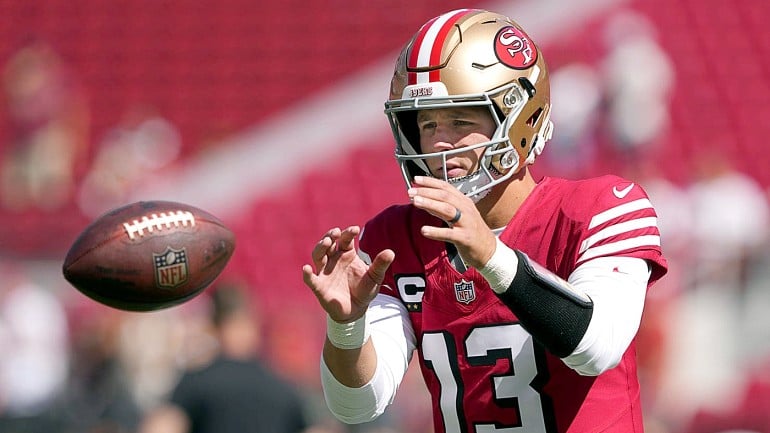With the 2013 NFL draft fast approaching, the 49ers have suddenly realized they have accumulated far too many draft choices. Pending future trades, they could end up with as many as fourteen picks, which must be expended over the course of just three days. The recent free-agency frenzy only increases the pressure to make perfect picks. Talk about multi-tasking! The personnel department must vet every single possible choice for athletic ability, character, medical history, team needs, projected salary-cap cost, and roster flexibility, not to mention individual affability on long flights.
How would you like to sit next to someone who continuously obsesses about football while the twinkly lights of Midwestern farms pass far below? The NFL schedule compels west-coast teams to take several such cross-continental trips each season. What if a recent draft pick's head lolls over during a return red-eye flight, jostling his earphones loose to spew the sounds of some cult band throughout the cabin? How would you like to room with someone who channel surfs fiendishly at max volume till the wee small hours, and never ever thinks of counting sheep? Or, conversely, thinks of counting sheep too much, or can't count at all? The business of the NFL often requires "cruel-to-be-kind" management tactics. You get the idea.
But what really causes consternation among some football executives emanates from the "war room," the place during the course of the draft where team experts congregate to make the actual decisions on each pick. This "on-the-clock" crisis time as the tick-tocks dwindle down to a precious few before the team rep in Radio City Music Hall (2013 venue) must deliver the little card with the actual player's name on it to the front of the cavernous room, with prying cameras frantically digitizing for posterity, and battalions of commentators poised to point out your every foolish choice, your rank dimwittedness, or, perhaps even, your dubious sanity, induces severe stress. Understandably.
To combat this "war room" shellshock, many teams set up, adjacent to the war room itself, but off limits to reporters and out of camera range, other rooms: the therapy room, where folks can go to sit on long couches and talk about their childhoods with imaginary therapists; the yoga room, self-explanatory and effective for some; the hopscotch room, where employees, many of them former athletes, can draw on the floor with chalk, and then hop around randomly (also known as the bunny room); and the pillow room, where executives can retreat to pound on each other with pillows, some embroidered, some not.
But, of all these side-rooms, the most popular, by far, remains the hammock room. That's right, eminent readers: many NFL-personnel-experts, to evade overweening personnel stress, actually sleep during the entire draft. Wouldn't you?
How, then, do these all-important picks get made? Many involve some combination of dice, coin flips and decks of cards. But the most prevalent device for choosing prospective players, reliable even under duress, resurrects the old hat-trick method (also known as the "wabbit twick) wherein, from the top five names remaining on a team's draft board, hastily scribbled upon slips of paper, someone with a rabbit's foot in his back pocket simply pulls a name from a derby, or helmet, or toupee. Then a team representative repairs to the interview station and proclaims to the entire baited-breath football world that his organization, miraculously, just selected the exact player they had all along coveted at the perfect place in the draft. High-fives all around.
Still, this method, while seeming carefree, perhaps even cavalier to casual fans, does not entirely eliminate stress. The correct hat must be selected, and also the proper kinds of paper, ink, and cleaning solutions. Also, what if the hand-selected name arrives at the commissioner's podium misspelled? The commissioner and crew already have notorious trouble with mispronunciations. How can the 49ers, with so many picks piled up, cope with such handwringing, hat-brim bending, shoulder-pad stooping dilemmas?
If we may, a modest proposal: a little-known NFL draft rule permits teams, when their turn comes up, to pass on the selection. That's right. The 49ers could pass, not once, not twice, but every single time their pick comes up, over and over, for every single selection in each round. Then, at the very end of the seventh-and-last round, they simply gather up the top remaining names on their admittedly now-depleted draft board, and throw caution to the gentle Candlestick winds. They don't even use the hat! In a magnificent move of profound boldness, they send the entire fistful of player-selection cards up to the commissioner's station, and plop them down confidently onto the floor at his feet. Let the commissioner's staff sort out which player gets the honor of being the very last selected, and forestall that gut-wrenching responsibility too.
Oh, how the other, envious organizations will writhe in collective agony, knowing that they had anticipated signing many of these same final fifteen players as undrafted free agents! Curses, foiled again by those tricky Niners. Then, at curtain in NYC, the entire jubilant 49ers staff could retrieve their stress-reducing squeezy balls and doodle sheets, raise their carrot-juice glasses high and, as they exit, salute the millions in the bowels of the Music Hall, and, indeed, throughout the world, with a resounding "That's all, folks!"



